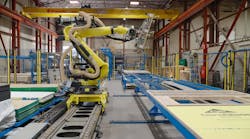The desire to increase building energy efficiency has led to the lofty goal of creating zero-energy buildings. The building-controls industry will play a major role in this quest, and we must understand and support and promote technologies to make zero-energy buildings easier to achieve. This article outlines the definition and how we should adjust our thinking when dealing with these buildings.
Definition
A zero-energy buildingis also known as a zero-net-energy building, a net-zero-energy building, or a net-zero building. These buildings have a net-zero energy consumption and net-zero carbon emissions annually. Buildings that produce a surplus of energy over the year may be called "energy-plus buildings" and buildings that consume slightly more energy than they produce are called "near-zero energy buildings" or "ultra-low energy buildings."
Most zero-energy buildings are connected to the electrical grid but some are independent of grid. Energy is usually harvested on-site through a combination of energy-producing technologies such as solar and wind, while reducing the overall use of energy with highly efficient HVAC and advanced lighting technologies.
The zero energy concept allows for a wide range of approaches—there are numerous options for producing and conserving energy and many ways of measuring energy (relating to cost, energy, or carbon emissions).1
http://www.zeroenergycbc.org/ is the Web site for the Zero Energy Commercial Building Consortium.
http://zeb.buildinggreen.com/ is a database of well-known buildings which meet zero-energy goals.
Measurement
The first goal in creating a net-zero-energy building is to minimize the actual systems involved in the building’s energy consumption so that the amount of energy which must be produced on-site to offset the building use is minimized. Once this is done and defined, the quantity and capacity of the site-generated energy can be defined.
Proper metering of the systems and loads in the building must be designed. In addition, metering of the site-generated power is a must and of course the utility will require some type of net meter to document the overall energy surplus or debit. One must understand that a net-zero-energy building does not need to be net zero all the time. The term net zero is used to note, over a certain amount of time, the building’s energy use offset by its energy production.
A good example of this is a building which has a photovoltaic (PV) solar panel array. During a day with a clear sky, the PV system will be generating power, and hopefully will fully offset the energy use of the building. In some cases, this PV power will be greater than the building’s energy use and the meter will actually spin backwards. The site will be feeding power into the grid.
In another example, a generator could run at night when it is less disruptive or perhaps more efficient because of weather conditions. The building could dump power into the grid, offsetting the power used during the day. This energy data is usually calculated every month and summed annually to determine if a building is truly overall net zero, although it is not net zero every minute of every day. To track this energy data well (and not wait until the end of the month or year), a utility dashboard or advanced metering system should be provided.
This brings up another issue. The U.S. Environmental Protection Agency’s (EPA’s) ENERGY STAR Program includes a rating system set up to label buildings from 1 to 100 (100 being the most efficient and 1 being the least efficient). This compares buildings to their “peers,” similar to the grading of tests in school—and we all know this grading was not a level playing field nor were the rules applied uniformly. With the advent of power generating systems such as PV, wind and renewable energy equipment, the scales are tipped in favor of buildings equipped with these technolgies. You could have a very efficient building with advanced HVAC and lighting system designs but no generation being compared to an average HVAC and lighting design with a large generation system. Overall energy use being ranked on a mean scale could drastically affect the score. An ENERGY STAR building should be just that: one that operates exceptionally, not a poor building that has multiple “tutors” propping up its score.
It is believed that the EPA will address this soon.
Advanced Controls
Net-zero-energy buildings either have bare bones systems (day-lit, naturally ventilated, with low plug loads) with little need for controls (these are the initial net-zero-energy-building designs), or have more advanced energy systems which need optimized control. These advanced systems are what our control industry should focus on to help the designers maximize building efficiencies.
Controls must evolve from the HVAC realm and encompass lighting systems, envelope control, transportation, water systems, and plug loads. All energy consumption should have integrated controls: window and door closure contacts to prevent heating and cooling when windows are opened and then forgotten; advanced occupancy systems in the seats, desks, or floors to ensure unoccupied areas are not conditioned or lit; and advanced metering, dashboards, and utility management systems to communicate energy use in real time are a must. Fuzzy logic programming for optimized start-stop, temperature, and pressure-reset algorithms will need to be incorporated. The controls industry should support and encourage this type of development, but the main focus should be on highly efficient building design and then offset that minimal use with PV and wind-renewable power.
Reference
1. This definition was referenced from Wikipedia but was clarified for this article.
J. Christopher Larry PE, CXA, CEM, CEP, CIPE, LEED AP, is the Director of Energy Engineering for exp, in Richmond, VA. He has spent more than 25 years working to minimize the building industry’s energy and environmental footprint through refining building design, building modeling, performance optimization, and intelligent controls. He won Energy Engineer of the Year in 2000 from the Association of Energy Engineers (AEE). He has held numerous positions within ASHRAE, including chairman of the Chapter Technology Transfer Committee and chairman for Technical, Energy and Governmental Activities. He is a past president of AEE and has instructed the certified energy manager training course for AEE. He is the current chairman for the Building Intelligent Quotient (BIQ) within the Continental Automated Buildings Association (CABA) and also is a member of the Zero Energy Commercial Building Consortium.








